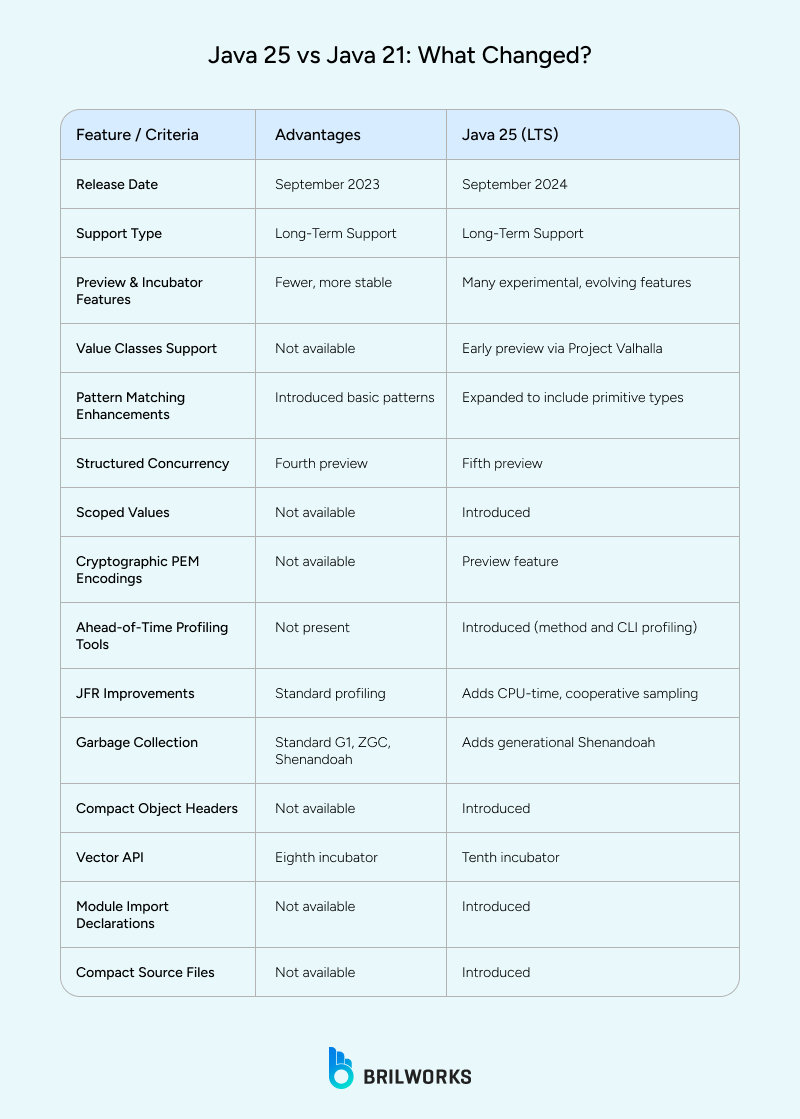COOPERATION MODEL
ARTIFICIAL INTELLIGENCE
PRODUCT ENGINEERING
DevOps & Cloud
LOW-CODE/NO-CODE DEVELOPMENT
FRONTEND DEVELOPMENT
CLOUD DEVELOPMENT
MOBILE APP DEVELOPMENT
LOW CODE/ NO CODE DEVELOPMENT
EMERGING TECHNOLOGIES








The Java programming language has been the backbone of enterprise systems for decades, running everything from Android apps to large-scale financial platforms. Its steady evolution—guided by a predictable release cycle—has made it one of the most trusted technologies in software development.
Now comes the next milestone. The Java 25 release, scheduled for September 2025, will take over as the latest LTS (Long-Term Support) version. With it comes a slate of new features, performance improvements, and groundwork for Project Valhalla that signal where the platform is heading.
Java 25 brings real changes to how developers write and structure code. To get the most out of it, you need people who know how to work with both the new features and the old foundations. Hire Java developers who can help you modernize safely, avoid tech debt, and build software that’s easier to maintain going forward.
Java 25 will be released in September 2025 and, as the new LTS version, will set the baseline for the next several years. Most enterprises prefer upgrading during LTS cycles since they guarantee long-term stability and security.
For teams still on Java 11 or 17, this release is an opportunity to close performance and security gaps. For those already on Java 21, it’s more about staying aligned with the ecosystem as tools and frameworks begin tuning for Java 25.

The Java 25 update adds refinements that trim away some of Java’s traditional verbosity:
Primitive Types in Patterns (Preview): Pattern matching now supports primitives like int and double, eliminating the need for explicit casting.
Flexible Constructor Bodies (Final): Constructors can now include initialization code before chaining, a long-requested fix.
Compact Source Files and Instance Main Methods (Final): Small programs and teaching examples no longer require full boilerplate classes.
Module Import Declarations (Final): Reduces repetitive imports when using modular libraries.
Taken together, these are not flashy changes, but they remove friction developers feel in day-to-day coding.
The standout focus of Java 25 is runtime efficiency:
Scoped Values (Final): A safer, faster alternative to thread-local variables, especially valuable in concurrent systems.
Compact Object Headers (Final): Lower memory footprint, freeing cache space in data-heavy applications.
Generational Shenandoah (Final): Brings generational collection to the Shenandoah GC, improving throughput and reducing pauses.
Ahead-of-Time Profiling (Final): Reuses profiling data for quicker startup and warm-up times.
For large-scale deployments, these Java 25 performance improvements mean more efficient memory usage and smoother operations under load.
Java 25 also strengthens the surrounding ecosystem:
JFR Method Timing and Tracing (Final): Adds method-level profiling without instrumentation.
JFR Cooperative Sampling (Final): Cuts profiling overhead by collecting data at safe points.
JFR CPU-Time Profiling (Experimental): Enables CPU-time analysis on Linux for better diagnostics.
Key Derivation Function API (Final): Standardizes secure key generation, supporting Argon2 and HMAC, a big step for security protocols.
PEM Encodings in the Java API (Preview): Native PEM support means one less external dependency.
It’s a continuation of how Java tooling continues to evolve to meet enterprise demands.

For years, Project Valhalla has aimed to rethink Java’s type system. Java 25 doesn’t deliver the final vision yet but puts down important markers:
Compact object headers for value classes
Tighter memory layouts for better cache use
Enhanced runtime metadata for identity-free objects
This direction is particularly relevant to workloads in AI and machine learning use cases, where efficiency at scale is critical.
Both are LTS releases, but Java 25 extends the platform in several important areas.

The Java 25 improvements in concurrency, memory, and profiling make it the stronger long-term choice.
32-bit x86 support is gone. Java is now 64-bit only.
Legacy internal APIs are phased out.
The removals are minimal, so most modern codebases will transition without disruption.
For teams on Java 11 or earlier, the case is straightforward: the Java 25 release delivers huge leaps in performance, memory efficiency, and security. For teams already on Java 17 or 21, the upgrade is less urgent but worth planning—frameworks and libraries will begin prioritizing Java 25 as their default LTS.
This is also a chance to revisit application Modernizing strategies. With the right developers who understand where Java is heading, migration doesn’t have to be disruptive. Many organizations choose to Hire Java developers specifically for this stage: testing compatibility, updating dependencies, and future-proofing critical systems.
The Java 25 release isn’t about a single headline feature, it’s about refinement. Cleaner syntax, smarter memory handling, more capable garbage collection, stronger security, and a steady move toward Project Valhalla all add up to a platform ready for the next decade.
If you’ve been holding off on upgrading, this is the version that makes sense to adopt. And if you’re already on 21, keeping pace with 25 ensures you stay aligned with the ecosystem’s direction. With the right team, you can make the move smoothly and unlock the full value of this long-term support release.
Yes, Java 25 is an LTS release. That means it will receive long-term updates and support, making it a stable choice for production environments.
If you want access to the latest features, performance improvements, and memory optimizations, upgrading to Java 25 is worth considering. However, test compatibility before switching in production.
Value classes are identity-free types introduced under Project Valhalla. They behave like regular classes in code but are optimized for performance like primitives in memory.
Java 25 includes a mix. Some features are finalized, while others are still in preview, incubator, or experimental stages. You can opt in to try them using compiler flags.
Java 25 signals a shift toward more efficient memory handling, better performance, and cleaner APIs. It’s a good time to explore how modern Java can improve your architecture.
Get In Touch
Contact us for your software development requirements
Get In Touch
Contact us for your software development requirements